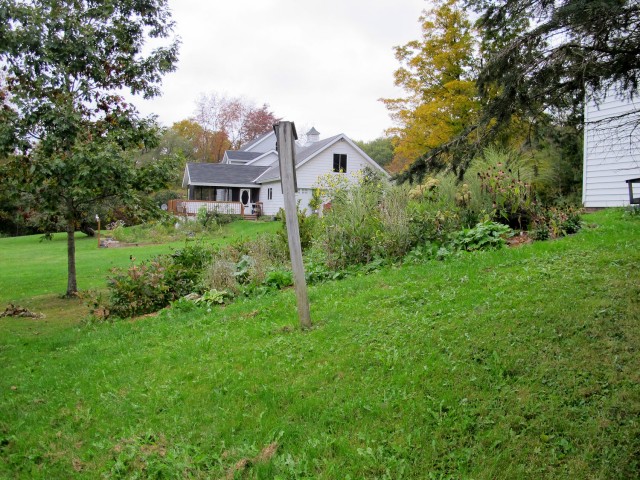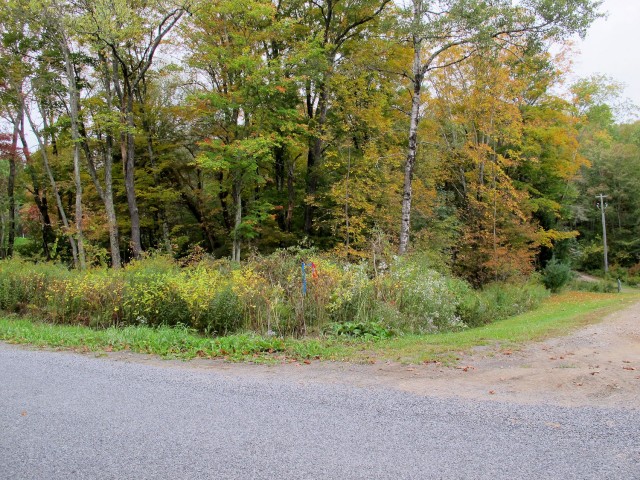I picked up Roy Diblik’s The Know Maintenance Perennial Garden from the library shelf because I knew the author supplied the plants for the Lurie Garden in Chicago, working closely with designer Piet Oudolf, and I wanted to learn more about the naturalistic style of gardening that both of these men espouse. Yes, there is much to learn about naturalistic gardening (also called Dutch Wave, New Wave, and the New Perennialism) in this book, but I was utterly charmed by Diblik’s love of plants. He loves plants, and he wants you to love plants, too. The point of the punny title is that once you know plants, you will know how to care for them efficiently, but even more than that, once you know them you will love them and will be able to express your own sense of beauty through them.
So many gardening books seem to avoid discussing the emotional and creative aspect of gardening. Instead, the goal seems to be something practical or perhaps virtuous: provide food for your family, improve the resale value of your house, save the planet! And Diblik does want to save the planet, or he wouldn’t have written this book. Ecology is the foundation of this way of gardening–but not the point of it. A richer life for the gardenere is the point, in his view.
The naturalistic style of gardening aims to create an artificial plant community that is nearly self-sustaining. (By artificial, I mean it wouldn’t occur exactly that way in the wild.) There is no mulching, as the garden plants cover every inch of ground (or close to it). There is no fertilizing, as the debris from the plants themselves will feed the planting as it decays. As a matter of fact, Diblik recommends mowing the whole thing down in late winter or very early spring with a mulching mower, making several passes so everything is chopped into bits, the more readily to rot in place. Mowing is not done sooner because the dead plants are considered to have their own unique beauty. In fact, plants are chosen in part for how well they look when dead. Diblik doesn’t pretend there is no weeding, but he tells you when the critical times are for catching weeds small, warns you of the most pernicious weeds that must be removed early, and describes a weeding technique that should make the job go quickly.
One thing that bothers me about this book is it is aimed at beginners. It is so far removed from what is thought of as traditional gardening practices that I think beginners will be a bit put off. However, for those who have been attracted to the gardens designed by Piet Oudolf and others but have been at a loss as to how to get started, this book provides a way in. But, really, this is a wonderful book for beginners precisely because he encourages the reader to observe and learn more about their plants by what they see. The first two chapters, “Understanding Your Garden” and “Understanding Plants,” cover things that most beginners don’t think of–and should.
Another thing that disturbs me is his procedure for starting such a bed seems to make no allowance for rocks: Kill the sod and leave it in place, and then use a tile spade to plant your selections according to the plan you have chosen. But what if your tile spade hits a rock one inch down? And what if you move the spade over six inches and still hit rock? I can easily imagine digging an eighteen-inch wide hole just to plant one six-inch container, because it’s happened to me before. And then Diblik’s instruction to avoid turning over the soil is meaningless and the goal of leaving as much sod as possible in place is lost. I have no good answer for this.
I especially love his plant profiles because they go beyond the usual statistics (hardiness zone, bloom color, etc.) and provide a description that really gives you a feel for the plant, how it might behave in your garden. There are a lot of plants I hadn’t heard of before and will be keeping an eye out for.

I’ve been attempting to apply “Know Maintenance” to the slope garden. I’m looking for more ideas and a little more direction. Diblik’s book has both.
I have been reading about and exploring this type of gardening in my online browsing, but The Know Maintenance Perennial Garden is the first book I’ve read on the subject. Other books I plan to read are:
- Planting in a Post-Wild World: Designing Plant Communities for Resilient Landscapes
- Planting: A New Perspective
- The Living Landscape: Designing for Beauty and Biodiversity in the Home Garden
- The Rambunctious Garden: Saving Nature in a Post-Wild World
And here are some of the gardens that have gotten me interested in this way of gardening:
I’m certainly going to have a lot to think about this winter. How about you?






Knowing our plants is essential. I think the book The Living Landscape, written by two of my favorite gardeners and writers, Rick Darke and Doug Tallamy is terrific. As I plan and plant my new ‘urban’ garden I am concentrating on natives, shrubs and tree, and since I know my site I am concentrating on plants that love or at least have good tolerance for wet sites. The new garden is very very different from my country garden out in the sun so I am having a busy time learning about new plants.
Thanks for your honest book review, I still think I’d read it. Now that my garden is seriously winding down, I’m ready to settle by the fireplace, drink many cups of tea with pumpkin desserts and read read read until Spring =) And I laughed out loud at the photo of the plot you thought was owned by the neighbor. Oh, how I have shared that experience. Ha. Which reminds me of all the work I need to do today.
Thanks for the review Kathy. I too have a Bermuda grass issue (it is actually illegal to sell it here in Northern Utah). So even though a no till/dig approach is preferred here in our high desert climate to discourage the long-lived weed seeds from germinating, if I don’t thoroughly remove every stolen and rhizome of the Bermuda grass, it just takes over in just one season. I really like the idea of the naturalistic approach, but I think I would be asking for trouble! Might be a good winter read though. I had not heard about the author before so thanks for the introduction.
I’m a new follower from North UK with a wet, windy and often cold garden. I enjoyed this review thanks and will read the book. I have a couple of Piet Oudolf’s books and about to finish Rambunctious Garden – which is very interesting but more about the ecology of the whole planet rather than a garden book. But still worth a read. ????
Great review Kathy. You know your part about rocks? Well, in my case, I don’t have so many of those, but I have Bermuda grass which can’t be smothered. Some people use a herbicide while others dig out the space. Different parts of the country require such different methods. Thanks for reading this and letting us know what you thought. I love The Living Landscape btw.~~Dee
I have a couple “wild” gardens. I plant aggressive perennials and let them duke it out and then try to weed once a year. My husband mows them in the fall to contain the brambles and tree seedlings. They are on the peripheral areas of my property – I call them meadows which sounds better than wild and there is some management involved.
Hi Kathy, you have done a great job reviewing this book. Even though I am not a beginner gardener, I can always use more plant information and as you so kindly mention, I am a devotee to the Piet school of naturalistic planting.
I have been gardening in a similar way for quite some time. I have no idea why people clean up their gardens so much. If you let the hosta leaves rot in place it takes care of the weed seeds underneath them, it creates a huge swathe of weed free area all around them. There are some things that I choose to tidy, like hellebore leaves, but that is a conscious choice, nature doesn’t cut them back every year.
That is a great book to read – I’ll look it up. I was gravitating towards natural, low maintenance garden and now have a way to describe it.
Hi Oksana,
I am already reading this book. To be honest It could be really useful for you if you are keen on natural gardens. 🙂 It could help you in many ways. It is worth it.
Oh, this sounds like the book for me! I think I am halfway there already. I love this style of planting and “know maintenance” really appeals to me right now. Thank you so much for bringing this book to light! I can vouch for the Living Landscape – fascinating/changing-perspective book. Great, I have a good winter read now. Thanks again.